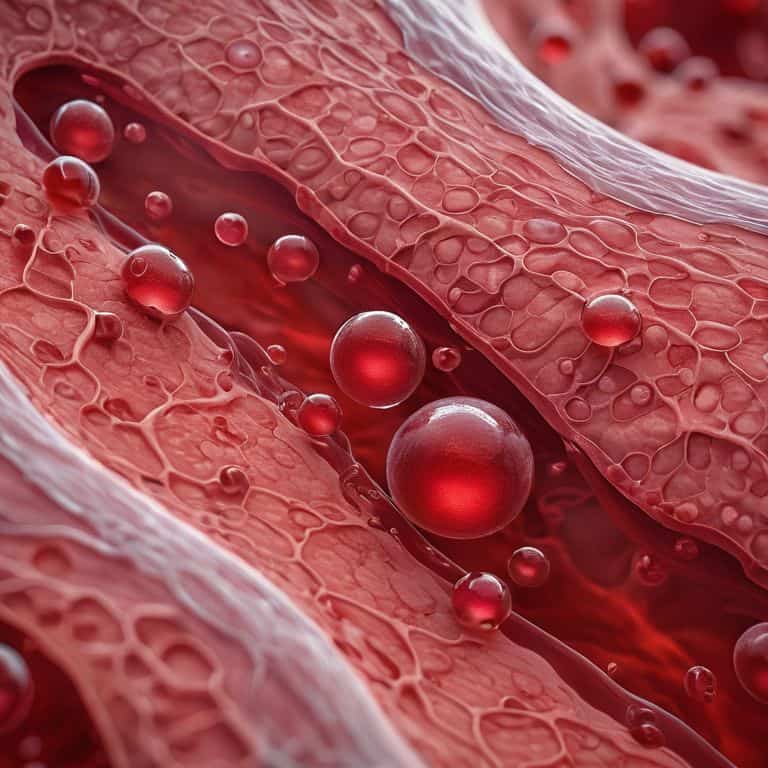I still remember the frustration I felt when I first started looking into improving circulation. Everywhere I turned, there were claims of miracle cures and magical supplements that would somehow boost blood flow and transform my health overnight. The problem was, none of these solutions were backed by real science. As someone who’s spent years studying the effects of chronic stress on the brain, I knew that genuine wellness required a more nuanced approach. I’ve seen far too many people fall prey to expensive myths and overcomplicated routines, only to end up disappointed and disillusioned.
As a former research scientist turned wellness consultant, I’m committed to cutting through the hype and providing you with evidence-based strategies for improving circulation. In this article, I’ll share my personal experience and knowledge to help you make informed decisions about your health. I’ll show you how to separate fact from fiction and develop a realistic plan for boosting blood flow and taking control of your cardiovascular health. My goal is to empower you with the tools and knowledge you need to achieve genuine wellness, without resorting to pseudoscience or marketing fluff. Let’s get started on this journey together, and discover a more effective, science-backed approach to improving circulation.
Table of Contents
Improving Circulation

When it comes to enhancing blood flow, natural remedies for poor circulation can be a great starting point. One often overlooked aspect is the importance of hydration for blood flow. Drinking enough water helps maintain blood viscosity, allowing it to flow more easily through your veins. On the other hand, dehydration can lead to thicker, more viscous blood that’s harder to pump, putting extra strain on your heart.
Regular massage therapy has also been shown to have a positive impact on vascular health. By stimulating blood vessels and promoting relaxation, massage can help to reduce stress, which is a significant factor in maintaining healthy blood flow. Chronic stress can cause blood vessels to constrict, restricting blood flow and potentially leading to more severe health issues.
In terms of lifestyle changes, quitting smoking is essential for improving vascular health. Smoking damages the lining of blood vessels, making them more susceptible to blockages and reducing overall blood flow. Additionally, incorporating omega-3 rich foods into your diet can help to reduce inflammation and promote healthier blood vessels, further supporting the health of your cardiovascular system.
Hydrations Role in Blood Flow
Hydration plays a crucial role in maintaining healthy blood flow. Proper fluid balance is essential to ensure that blood can flow freely to all parts of the body. Even mild dehydration can cause blood vessels to constrict, reducing circulation and leading to a range of negative effects.
To stay hydrated, it’s essential to drink plenty of water throughout the day. Adequate hydration helps to keep blood vessels flexible and able to dilate as needed, allowing for optimal blood flow. By making hydration a priority, individuals can take a significant step towards improving their overall circulation and reducing the risk of related health issues.
Natural Remedies for Poor Circulation
When it comes to addressing poor circulation, many of us turn to natural remedies. One approach that has garnered significant attention is the use of ginger, which has been shown to have a positive impact on blood flow. However, it’s essential to separate fact from fiction and look at the actual science behind these claims.
In my experience, evidence-based botanicals can be a valuable addition to a circulation-friendly lifestyle. Certain herbs, such as ginkgo biloba, have been studied for their potential to improve blood flow and overall cardiovascular health.
Science of Better Blood Flow

As we delve into the science of better blood flow, it’s essential to understand the intricate mechanisms that govern our vascular health. The importance of hydration for blood flow cannot be overstated, as it plays a crucial role in maintaining the delicate balance of fluids within our blood vessels. Dehydration, on the other hand, can lead to a decline in blood flow, making it more challenging for our bodies to deliver oxygen and nutrients to our cells.
The impact of smoking on vascular health is another critical factor to consider. Smoking damages the inner lining of our blood vessels, leading to a decrease in blood flow and increasing the risk of cardiovascular disease. In contrast, natural remedies for poor circulation, such as massage therapy, can help to improve blood flow by promoting relaxation and reducing inflammation. By incorporating these therapies into our daily routines, we can take a proactive approach to maintaining healthy blood vessels.
By understanding the effects of stress on blood vessels and the benefits of omega-3 fatty acids in improving circulation, we can make informed decisions about our lifestyle choices. Role of omega-3 in improving circulation is particularly noteworthy, as these essential fatty acids have been shown to reduce inflammation and promote healthy blood flow. By combining these evidence-based strategies with a balanced lifestyle, we can take significant strides towards maintaining optimal vascular health and promoting overall well-being.
Massage Therapy for Circulation
As I hit the trails for a run, I often think about how physical manipulation of muscles can impact circulation. Massage therapy, in particular, has been shown to have a positive effect on blood flow. By applying gentle to firm pressure on specific areas of the body, massage can help to dilate blood vessels and increase oxygen delivery to tissues.
Regular massage sessions can also help to reduce muscle tension, which can constrict blood vessels and impede circulation. I’ve seen studies that suggest manual therapy can be a useful adjunct to other treatments for improving circulation, especially in individuals with sedentary lifestyles or those who are recovering from injury.
Omega 3s Impact on Vascular Health
As I hit the trails for my morning run, I often ponder the intricate relationships between nutrition, physical activity, and cardiovascular health. Omega-3 fatty acids, in particular, have garnered significant attention for their potential benefits on vascular health. Research suggests that these essential fatty acids can help reduce inflammation and improve blood lipid profiles, which in turn can enhance blood flow and overall circulation.
The anti-inflammatory effects of omega-3s are well-documented, with studies demonstrating a positive correlation between omega-3 supplementation and improved vascular function. By incorporating omega-3 rich foods, such as fatty fish or flaxseeds, into one’s diet, individuals can potentially mitigate the risk of cardiovascular disease and promote healthier blood flow.
Evidence-Based Strategies to Enhance Circulation
- Engage in regular aerobic exercise, such as brisk walking or cycling, to stimulate blood flow and strengthen cardiovascular health
- Incorporate stress-reducing activities like meditation or yoga to mitigate the negative effects of stress on circulation
- Maintain a balanced diet rich in fruits, vegetables, and whole grains to support vascular function and overall well-being
- Consider incorporating omega-3 fatty acid supplements into your routine, as they have been shown to improve blood lipid profiles and promote healthy blood flow
- Prioritize getting at least 7-8 hours of sleep per night to allow your body to repair and rejuvenate its circulatory system
Key Takeaways to Boost Your Circulation
Prioritize evidence-based lifestyle changes, such as regular physical activity and a balanced diet, to improve blood flow and overall cardiovascular health
Stay hydrated by drinking plenty of water and limit your intake of sugary drinks and caffeine to support healthy blood flow and circulation
Consider incorporating science-backed therapies like massage and omega-3 supplements into your routine, but always consult with a healthcare professional before starting any new regimen
Cutting Through the Hype
Improving circulation isn’t about chasing the latest fad or quick fix; it’s about embracing a holistic approach that weaves together lifestyle changes, evidence-based remedies, and a deep understanding of the intricate dance between our bodies and the environment.
Dr. Alistair Finch
Taking Control of Your Circulation

As we’ve explored throughout this article, improving circulation is not just about quick fixes or miracle cures, but about making informed lifestyle choices that are backed by science. From natural remedies like hydration and massage therapy, to the importance of omega-3’s in maintaining vascular health, the key to better blood flow lies in understanding the complex interplay between our daily habits and our bodily functions. By focusing on evidence-based strategies and ditching the pseudoscience, we can take the first steps towards a healthier, more resilient cardiovascular system.
So, as you move forward on your journey to optimal wellness, remember that every small change counts. Whether it’s incorporating more physical activity into your daily routine, or simply being more mindful of your hydration levels, the power to transform your health is in your hands. Don’t be swayed by the latest fads or gimmicks – instead, trust the science and trust yourself to make informed decisions that will benefit your body and mind for years to come.
Frequently Asked Questions
What are the most effective exercises to improve circulation, especially for those with limited mobility?
For those with limited mobility, gentle exercises like chair yoga, tai chi, or short walks can help improve circulation. Even simple movements like ankle rotations, toe wiggles, and wrist extensions can be beneficial. The key is to start slow and listen to your body, gradually increasing intensity and duration as you become more comfortable.
Can certain foods or dietary supplements, such as garlic or ginger, really help improve blood flow?
While some claim garlic and ginger improve blood flow, the science is mixed. Limited studies suggest potential benefits, but results are largely anecdotal. As a neuroscientist, I recommend a balanced diet rich in omega-3s, antioxidants, and whole foods, which have proven benefits for cardiovascular health, rather than relying on unproven supplements.
How does stress impact circulation, and are there any evidence-based stress reduction techniques that can help mitigate its effects?
Stress can significantly impede circulation by causing blood vessels to constrict. To combat this, I recommend evidence-based techniques like mindfulness meditation, which has been shown to reduce stress hormones and improve blood flow. Regular exercise, such as trail running, can also help mitigate stress’s impact on circulation.
